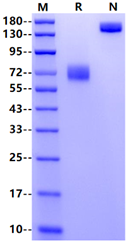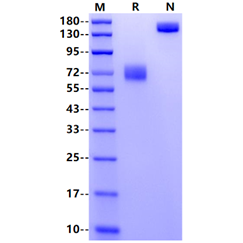1μg (R: reducing conditions, N: non-reducing conditions).
Product Details
Product Details
Product Specification
| Species | Mouse |
| Synonyms | CRF2-4, Crfb4, IL-10R2, Il10r2 |
| Accession | Q61190 |
| Amino Acid Sequence | Met20-Ser220, with C-terminal Human IgG1 Fc MIPPPEKVRMNSVNFKNILQWEVPAFPKTNLTFTAQYESYRSFQDHCKRTASTQCDFSHLSKYGDYTVRVRAELADEHSEWVNVTFCPVEDTIIGPPEMQIESLAESLHLRFSAPQIENEPETWTLKNIYDSWAYRVQYWKNGTNEKFQVVSPYDSEVLRNLEPWTTYCIQVQGFLLDQNRTGEWSEPICERTGNDEITPSIEGRMDPKSSDKTHTCPPCPAPELLGGPSVFLFPPKPKDTLMISRTPEVTCVVVDVSHEDPEVKFNWYVDGVEVHNAKTKPREEQYNSTYRVVSVLTVLHQDWLNGKEYKCKVSNKALPAPIEKTISKAKGQPREPQVYTLPPSRDELTKNQVSLTCLVKGFYPSDIAVEWESNGQPENNYKTTPPVLDSDGSFFLYSKLTVDKSRWQQGNVFSCSVMHEALHNHYTQKSLSLSPGK |
| Expression System | HEK293 |
| Molecular Weight | 60-75kDa |
| Purity | >95% by SDS-PAGE |
| Endotoxin | <0.1EU/μg |
| Conjugation | Unconjugated |
| Tag | Human Fc Tag |
| Physical Appearance | Lyophilized Powder |
| Storage Buffer | PBS, pH7.4 |
| Reconstitution | Reconstitute at 0.1-1 mg/ml according to the size in ultrapure water after rapid centrifugation. |
| Stability & Storage | · 12 months from date of receipt, lyophilized powder stored at -20 to -80℃. · 3 months, -20 to -80℃ under sterile conditions after reconstitution. · 1 week, 2 to 8℃ under sterile conditions after reconstitution. · Please avoid repeated freeze-thaw cycles. |
| Reference | 1. Lutfalla, G. et al. (1993) Genomics 16:366. 2. Xie, M.-H. et al. (2000) J. Biol. Chem. 275:31335. 3. Kotenko, S.V. et al. (2003) Nat. Immunol. 4:69. 4. Yoon, S.I. et al. (2006) J. Biol. Chem. 281:35088. |
Background
Interleukin 10 receptor, beta subunit (IL10RB/IL-10RB) also known as Cytokine receptor family 2 member 4, Interleukin-10 receptor subunit 2, and cytokine receptor family II, member 4, is a subunit for the interleukin-10 receptor. Mature human IL-10 R beta consists of a 201 amino acid (aa) extracellular region with two fibronectin type-III domains, a 22 aa transmembrane segment and a 83 aa cytoplasmic domain. IL‑10 R beta is widely expressed, while the associated receptor subunits exhibit differential expression patterns. The ligand‑specific subunits are responsible for the divergent functions of these cytokines, encompassing immune suppression, promotion or inhibition of inflammation, mucosal defense, antiviral immunity, and hematopoiesis.
Picture
Picture
SDS-PAGE



